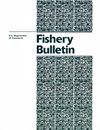Effects of salinity and turbidity on development of bamboo sole (Heteromycteris japonicus)
IF 0.8
4区 农林科学
Q3 FISHERIES
引用次数: 0
Abstract
— Heavy rain can decrease salinity and increase turbidity of the water in coastal areas, negatively affecting the development of organisms, par- ticularly during their early life stages. In this study, the effects of salinity and turbidity on embryos of the bamboo sole ( Heteromycteris japonicus ) were evalu- ated to improve understanding of its tolerance to global climate change. Three experiments were carried out over a 7- d period. In the first experiment, embryos of bamboo sole were exposed for 3 h to 1 of 6 salinity levels (14–34). Low salinity levels (14 and 18) resulted in signifi- cantly shorter total lengths of newly hatched larvae in comparison with larval sizes in treatments with higher salinities, but no significant differences were observed in hatching rate and larval survival rate among treatments. In the second experiment, embryos were exposed to turbidities of 0, 100, 300, 500, and 700 nephelometric turbidity units for 3 h. Turbidity significantly decreased hatching rate, survival rate, and total length and increased onset hatching time and percentage of abnormality. In the third experiment, embryos were exposed to different combinations of salinity and turbidity. The interaction effect of salinity and turbidity on total length of newly hatched larvae was significant. These findings indicate that embryo development of bamboo sole was more affected by盐度和浊度对竹比目鱼生长发育的影响
--大雨会降低沿海地区的盐度并增加水的浊度,对生物体的发育产生负面影响,尤其是在其生命早期。在本研究中,评估了盐度和浊度对日本异杆菌胚胎的影响,以提高对其对全球气候变化耐受性的认识。在7天的时间里进行了三个实验。在第一个实验中,将竹鞋底的胚胎暴露在6个盐度水平中的1个盐度水平下3小时(14-34)。与盐度较高的处理中的幼虫大小相比,低盐度水平(14和18)导致新孵化幼虫的总长度显著缩短,但不同处理之间的孵化率和幼虫存活率没有显著差异。在第二个实验中,胚胎暴露在浊度为0、100、300、500和700的浊度下3小时。浊度显著降低孵化率、存活率和总长度,并增加孵化开始时间和异常率。在第三个实验中,胚胎暴露在盐度和浊度的不同组合中。盐度和浊度对初孵幼虫总长度的交互作用显著。这些发现表明,竹鞋底的胚胎发育受到
本文章由计算机程序翻译,如有差异,请以英文原文为准。
求助全文
约1分钟内获得全文
求助全文
来源期刊

Fishery Bulletin
农林科学-渔业
CiteScore
1.70
自引率
12.50%
发文量
76
审稿时长
>24 weeks
期刊介绍:
The quarterly Fishery Bulletin is one of the oldest and most respected fisheries journals in the world. It has been an official publication of the U.S. Government since 1881, under various titles, and is the U.S. counterpart to other highly regarded governmental fisheries science publications. It publishes original research and interpretative articles in all scientific fields that bear on marine fisheries and marine mammal science.
 求助内容:
求助内容: 应助结果提醒方式:
应助结果提醒方式:


